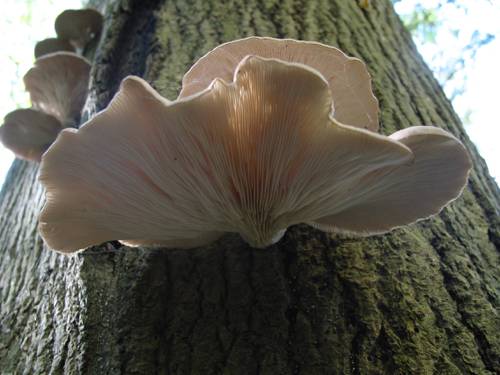
FAQ About Mycoremediation with Indoor Plants

What is mycoremediation?
Mycoremediation is the process of using fungi to decontaminate the environment. It involves the use of fungal mycelium to break down or absorb pollutants from soil, water, and air, converting them into less harmful substances. This biological process leverages the natural digestive properties of fungi to clean up contaminated environments.

Can mycoremediation be used indoors?
Yes, mycoremediation can be effectively used indoors by integrating fungi with indoor plants. This approach aims to purify indoor air and soil from various pollutants, creating a healthier indoor environment. Fungi work symbiotically with plants, enhancing their ability to capture and break down pollutants more effectively.

How do indoor plants contribute to air purification with fungi?
Indoor plants, through a process known as phytoremediation, naturally purify air by absorbing pollutants and toxins through their leaves and roots. When combined with fungi in mycoremediation, the plants' ability to clean the air is enhanced, as fungi can break down more complex pollutants into simpler, non-toxic forms, thus aiding in the overall purification process.

What types of fungi are commonly used in mycoremediation?
Commonly used fungi in mycoremediation include species like oyster mushrooms (Pleurotus ostreatus), white rot fungi, and mycorrhizal fungi. These species are known for their robust enzymatic systems, which are capable of breaking down complex pollutants such as hydrocarbons, heavy metals, and persistent organic pollutants.

Are there specific indoor plants that work well with fungi for purification?
Yes, certain indoor plants are particularly effective when used in conjunction with fungi for purification purposes. Plants such as the spider plant (Chlorophytum comosum), peace lily (Spathiphyllum), and snake plant (Sansevieria trifasciata) have shown great potential. They not only enhance the aesthetic of indoor spaces but also provide an excellent medium for fungi to attach and thrive.

How do fungi enhance the soil environment for indoor plants?
Fungi enhance the soil environment by breaking down organic matter into simpler compounds, making nutrients more accessible to plants. They form symbiotic relationships with plant roots, improving nutrient uptake, enhancing plant growth, and fortifying plants against diseases and environmental stress. This mutualistic association supports healthier indoor plants.

What pollutants can mycoremediation target in indoor environments?
Mycoremediation in indoor settings can target a range of pollutants including volatile organic compounds (VOCs), formaldehyde, benzene, and trichloroethylene. These are common indoor air pollutants that originate from furniture, paints, cleaning agents, and other household items. Fungi, combined with plants, help to effectively reduce these airborne toxins.

Is mycoremediation with indoor plants safe for home use?
Mycoremediation with indoor plants is generally safe for home use. It involves natural organisms that are non-toxic and non-invasive. However, it is essential to ensure that the specific fungi used do not produce spores that could trigger allergies or respiratory issues in sensitive individuals. Choosing appropriate fungal species and maintaining proper indoor conditions are crucial for a safe home environment.

How do I set up a mycoremediation system with indoor plants?
Setting up a mycoremediation system involves selecting appropriate plants and fungi, preparing the soil, and ensuring suitable environmental conditions. Start by choosing plants known for their air-purifying qualities. Inoculate the soil with fungi species that synergize well with your chosen plants. Maintain adequate humidity, light, and temperature to promote fungal growth and plant health.

Can mycoremediation help with mold problems indoors?
Mycoremediation can help manage certain mold issues indoors by introducing beneficial fungi that compete with or inhibit harmful mold species, thus reducing mold proliferation. However, it may not completely eliminate mold problems and should be part of a broader strategy including proper ventilation, humidity control, and regular cleaning.

What are the benefits of using mycoremediation with indoor plants compared to traditional air purifiers?
Using mycoremediation with indoor plants offers several benefits over traditional air purifiers. It provides a natural, sustainable way of improving indoor air quality without electricity or filters. The combination of plants and fungi can continuously break down and absorb pollutants, enhancing living spaces in a more ecological manner while also contributing to the aesthetic and mental well-being of inhabitants.

Do I need special equipment for mycoremediation in my home?
For basic mycoremediation at home, special equipment is generally not necessary. You will need pots, suitable soil, selected indoor plants, and fungal inoculants. Optional equipment might include grow lights or humidity regulators to create optimal conditions for plant and fungal growth, particularly in low-light or dry environments.

Can mycoremediation be used to treat contaminated soils in pots?
Yes, mycoremediation can be effective in treating contaminated soils in pots. Fungi, when introduced into the soil, can break down and stabilize pollutants, making them less harmful. Pairing this with plants that can absorb heavy metals or other contaminants adds another layer of purification.

How quickly does mycoremediation work in indoor environments?
The speed of mycoremediation in indoor environments varies based on factors such as the type of pollutants, fungal species, plant types, and environmental conditions. Generally, noticeable improvements in air quality can occur over weeks to months. Regular maintenance of the plants and fungi will help sustain and increase the effectiveness of the remediation process.

Can mycoremediation remove indoor odors?
Mycoremediation can contribute to the reduction of indoor odors by breaking down compounds responsible for unpleasant smells. Fungi can metabolize volatile organic compounds and other odorous substances, while plants help to absorb and neutralize them, creating a fresher indoor environment.

Are there any downsides to using mycoremediation indoors?
While mycoremediation is an eco-friendly method of cleaning indoor environments, there are some downsides. These include the potential for allergenic spore production, the need for sustained conditions to support fungal and plant health, and sometimes limited effectiveness with certain persistent pollutants. Careful management and selection of fungi and plants can mitigate these issues.

How can I monitor the effectiveness of my mycoremediation setup?
Effectiveness can be monitored by observing the health and growth of plants and using indoor air quality sensors to measure pollutant levels before and after setup. Increased plant vitality and improved air quality readings are good indicators that the mycoremediation system is working. Regular observation helps in making necessary adjustments to enhance the process.

What maintenance does a mycoremediation system require?
Maintenance involves regular watering, ensuring appropriate light and humidity levels, and monitoring fungal growth. Removing dead leaves and checking for signs of plant or fungal stress can prevent potential issues. Periodically, you may need to replenish fungal inoculants and ensure that the soil remains healthy and rich in nutrients.

Can mycoremediation be combined with other green technologies?
Yes, mycoremediation can be combined with other green technologies such as green roofs, living walls, and hydroponics to enhance environmental benefits. These combined systems can provide comprehensive ecological solutions, further improving air quality, aesthetics, and energy efficiency in buildings.
